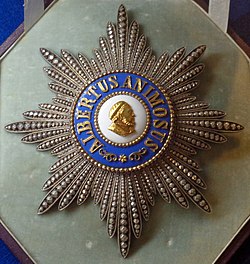Grades
The grade structure of the Albert Order changed several times.
At first, there were five classes: Grand Cross (Großkreuz), Commander's Cross 1st Class (Komturkreuz I), Commander's Cross 2nd Class (Komturkreuz II), Knight's Cross (Ritterkreuz) and Small Cross (Kleinkreuz). These provided the basis for a series of changes over the following forty years. On 18 March 1858, the Small Cross was renamed as the Honour Cross (Ehrenkreuz) and a sixth class was established with a gold and silver Merit Medal (Verdienstmedaille). A Merit Cross (Verdienstkreuz) with Swords was added on 29 October 1866 and this was extended on 9 December 1870 with the Merit Cross with Swords on Ring. [1]
The medals were abolished on 2 February 1876 and the Knights Cross was split into two classes. On 30 April 1884, a gold Great Cross was added and on 11 June 1890, the Officer's Cross was inserted into the Order between the Knight's Cross 1st Class and the Commander's Cross 2nd Class. [1] So, at its abolition in 1918, the Order was structured thus:
- Gold Grand Cross (Goldgroßkreuz)
- Grand Cross (Großkreuz)
- Commander's Cross 1st Class (Komturkreuz I. Klasse)
- Commander's Cross (Komturkreuz II. Klasse)
- Officer's Cross (Offizierskreuz)
- Knight's Cross 1st Class (Ritterkreuz I. Klasse)
- Knight's Cross 2nd Class (Ritterkreuz II. Klasse)
- Honour Cross (Ehrenkreuz)
- Merit Cross (Verdienstkreuz) with Swords
An award of Swords indicated a recipient's bravery in wartime. If, however, a recipient was subsequently awarded a higher grade in the Order, he could lose the bravery distinction attached to the superseded grade (regulations only allowed the display of the insignia of the highest awarded grade). This anomaly was solved in 1906 by allowing the addition of Swords by replacement of insignia. A recipient, however, had to pay the cost of replacement and this appears to have inhibited the numbers of such replacements. [3]
This page is based on this
Wikipedia article Text is available under the
CC BY-SA 4.0 license; additional terms may apply.
Images, videos and audio are available under their respective licenses.


